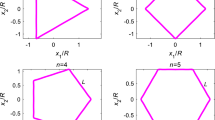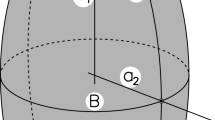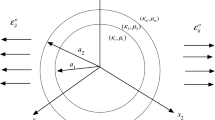Abstract
We study the three-dimensional problem of a spheroidal compressible liquid inclusion perfectly bonded to an infinite transversely isotropic elastic matrix subjected to a uniform axisymmetric stress field at infinity. The original boundary value problem is reduced to a set of three coupled linear algebraic equations. The internal uniform hydrostatic tension within the liquid inclusion and the elastic field of displacements and stresses in the matrix are then determined via the solution of this set of linear algebraic equations.











Similar content being viewed by others
Data Availability
No datasets were generated or analysed during the current study.
References
Eshelby, J.D.: The determination of the elastic field of an ellipsoidal inclusion and related problems. Proc. Roy. Soc. London A 241, 376–396 (1957)
Eshelby, J.D.: The elastic field outside an ellipsoidal inclusion. Proc. Roy. Soc. London A 252, 561–569 (1959)
Eshelby, J.D.: Elastic inclusions and inhomogeneities. Prog. Solid Mech. 2, 89–140 (1961)
Chen, W.T.: Axisymmetric stress field around spheroidal inclusions and cavities in a transversely isotropic material. ASME J. Appl. Mech. 35, 770–773 (1968)
Mura, T.: Micromechanics of defects in solids, 2nd, rev. ed. Martinus Nijhoff, Dordrecht, Netherlands (1987)
Zhou, K., Hoh, H.J., Wang, X., Keer, L.M., Pang, J.H.L., Song, B., Wang, Q.J.: A review of recent works on inclusions. Mech. Mater. 60, 144–158 (2013)
Eshelby, J.D.: Discussion: “Axisymmetric stress field around spheroidal inclusions and cavities in a transversely isotropic material” (Chen, W. T., 1968, ASME J. Appl. Mech., 35, pp. 770–773). ASME J. Appl. Mech. 36, 652 (1 page) (1969).
Style, R.W., Wettlaufer, J.S., Dufresne, E.R.: Surface tension and the mechanics of liquid inclusions in compliant solids. Soft Matter 11(4), 672–679 (2015)
Style, R.W., Boltyanskiy, R., Allen, B., Jensen, K.E., Foote, H.P., Wettlaufer, J.S., Dufresne, E.R.: Stiffening solids with liquid inclusions. Nat. Phys. 11(1), 82–87 (2015)
Wu, J., Ru, C.Q., Zhang, L.: An elliptical liquid inclusion in an infinite elastic plane. Proc. Royal Soc. A 474(2215), 20170813 (2018)
Chen, X., Li, M.X., Yang, M., Liu, S.B., Genin, G.M., Xu, F., Lu, T.J.: The elastic fields of a compressible liquid inclusion. Extreme Mech. Lett. 22, 122–130 (2018)
Krichen, S., Liu, L.P., Sharma, P.: Liquid inclusions in soft materials: capillary effect, mechanical stiffening and enhanced electromechanical response. J. Mech. Phys. Solids 127, 332–357 (2019)
Dai, M., Hua, J., Schiavone, P.: Compressible liquid/gas inclusion with high initial pressure in plane deformation: modified boundary conditions and related analytical solutions. Euro. J. Mech. A-Solids 82, 104000 (2020)
Dai, M., Schiavone, P.: Modified closed-form solutions for three-dimensional elastic deformations of a composite structure containing macro-scale spherical gas/liquid inclusions. Appl. Math. Modelling 97, 57–68 (2021)
Ti, F., Chen, X., Li, M.X., Sun, X.C., Liu, S.B., Lu, T.J.: Cylindrical compressible liquid inclusion with surface effects. J. Mech. Phys. Solids 161, 104813 (2022)
Ghosh, K., Lopez-Pamies, O.: Elastomers filled with liquid inclusions: theory, numerical implementation, and some basic results. J. Mech. Phys. Solids 166, 104930 (2022)
Ghosh, K., Lefevre, V., Lopez-Pamies, O.: The effective shear modulus of a random isotropic suspension of monodisperse liquid n-spheres: from the dilute limit to the percolation threshold. Soft Matter 19, 208–224 (2023)
Ghosh, K., Lefevre, V., Lopez-Pamies, O.: Homogenization of elastomers filled with liquid inclusions: the small-deformation limit. J. Elasticity 154, 235–253 (2023)
Duan, H.L., Wang, J., Huang, Z.P., Karihaloo, B.L.: Eshelby formalism for nano-inhomogeneities. Proc. Roy. Soc. A 461(2062), 3335–3353 (2005)
Wang, X., Schiavone, P.: Stress relaxation around an anisotropic elastic elliptical inhomogeneity with interface slip and diffusion (Submitted).
Acknowledgements
The authors are grateful to two reviewers for their constructive comments and suggestions. This work is supported by a Discovery Grant from the Natural Sciences and Engineering Research Council of Canada (Grant No: RGPIN-2023-03227 Schiavo).
Author information
Authors and Affiliations
Contributions
X.W. conceived the idea for the paper and prepared the first draft together with the figures. X.W. and P.S. performed the formal analysis and methodology. Both authors reviewed the final manuscript.
Corresponding authors
Ethics declarations
Competing interests
The authors declare no competing interests.
Additional information
Publisher's Note
Springer Nature remains neutral with regard to jurisdictional claims in published maps and institutional affiliations.
Appendix
Appendix
According to Chen [4], the displacements and stresses in the transversely isotropic elastic matrix are given explicitly by
where
and the two functions \(q_{\alpha } (r, \, z_{\alpha } ) \, (\alpha = 1, \, 2)\) are defined by
with
Rights and permissions
Springer Nature or its licensor (e.g. a society or other partner) holds exclusive rights to this article under a publishing agreement with the author(s) or other rightsholder(s); author self-archiving of the accepted manuscript version of this article is solely governed by the terms of such publishing agreement and applicable law.
About this article
Cite this article
Wang, X., Schiavone, P. A spheroidal compressible liquid inclusion perfectly bonded to an infinite transversely isotropic elastic matrix. Arch Appl Mech (2024). https://doi.org/10.1007/s00419-024-02610-9
Received:
Accepted:
Published:
DOI: https://doi.org/10.1007/s00419-024-02610-9




